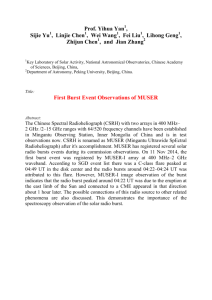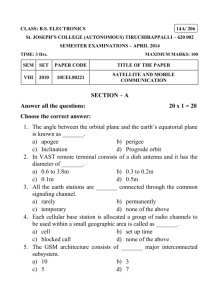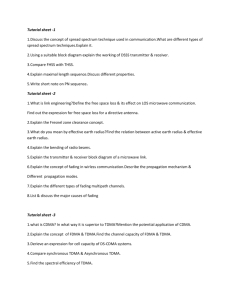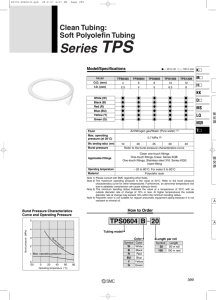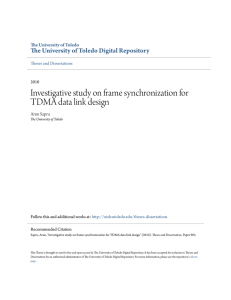ECE 5233 - Lecture 1..
advertisement
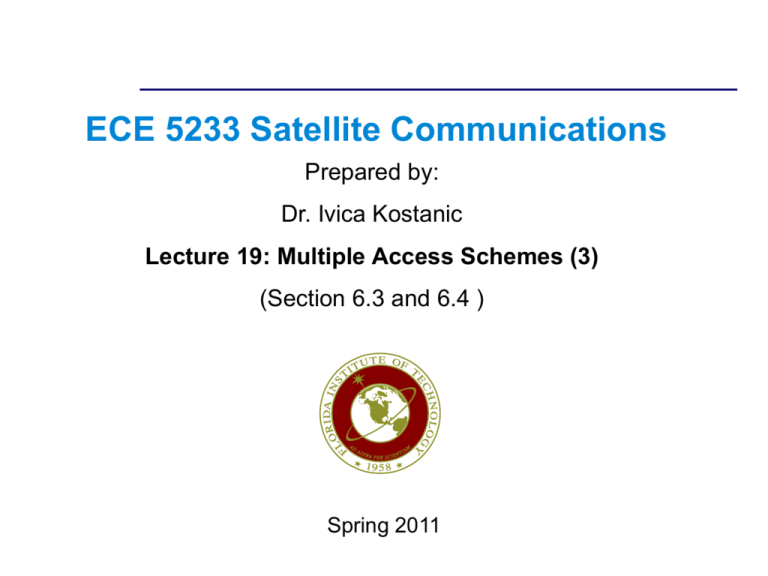
ECE 5233 Satellite Communications Prepared by: Dr. Ivica Kostanic Lecture 19: Multiple Access Schemes (3) (Section 6.3 and 6.4 ) Spring 2011 Outline TDMA link capacity calculation TDMA efficiency Synchronization in TDMA networks Transmit power in TDMA networks Examples Important note: Slides present summary of the results. Detailed derivations are given in notes. Florida Institute of technologies Page 2 Capacity and efficiency of TDMA Multiple earth station sharing transponder TDMA efficiency Time allocated for data transmission Td T frame Tp Tg T frame N Tp Tg i Total available rate for user traffic Ru Td RT T frame Ti Tpi Tgi T frame R T Note 1: guard and preamble times are usually the same for all earth stations Note 2: Rate of transponder depends on the bandwidth and modulation/coding scheme Rate for the ith user Rui Td 100 % T frame Ti Tp Tg T frame RT Florida Institute of technologies Page 3 Example Consider a satellite with following parameters o Frame duration: 2ms o Preamble duration (reference station): 4.77 us o Preamble duration (other earth stations): 4.63 us o Guard time: 1.06 us o Two reference burst per frame and satellite rate of 120Mbps Determine o Total user data rate (A: 115.82 Mbps) o Total user data rate if the satellite is shared by 10 equal earth stations (A: 11.58Mbps) o TDMA efficiency (96.52%) Note: in satellite networks TDMA efficiency is above 90% Florida Institute of technologies Page 4 TDMA synchronization Preamble example Synchronization stages o Carrier recovery – required for coherent demodulation o Bit synchronization – required for matched filter operation o Burst synchronization – required for decoding of individual earth stations o Frame synchronization – required for proper operation of TDMA Synchronization data is embedded in the burst preamble o CBTR (Carrier and Bit recovery) and o UW (Unique Word) Block diagram of QPSK RX Note: CBTR usually has two parts: un-modulated part – carrier recovery, modulated part for bit sync Florida Institute of technologies Page 5 Unique word decoding Unique word – modulated sequence of noise like autocorrelation properties Two approaches o Station identified – different unique word o Station identified – unique word + signaling Unique word determines the beginning of the frame at the receive side It is important that unique word has o High probability of detection Detection of UW sequence o Low probability of false alarm If unique word is not detected – earth station misses the entire frame Florida Institute of technologies Page 6 Synchronization between earth stations All earth station burst need to arrive in proper times For earth station n the burst needs to arrive at the offset dn with respect to reference burst The path traveled by each signal is different Define o SOTFn (Start of Transmit Frame) – time when the earth station needs to transmit so that its burst is arriving at the time of reference burst o SORFn (Start of receive Frame) – time when the earth station receives reference burst Example of burst time plan (SOTF = start of TX frame) SOTFn SORFn Dn mTF 2Rn / c Relationship between SOTF and SORF Note: earth station needs to Florida Institute of technologies estimate Dn Page 7 Determination of SORF-SOTF – closed loop Step 1. Earth station sends a shortened burst at the best estimate of SOTFn Step 2. The shortened burst is echoed by the satellite Step 3. Earth station observes the error between desired and actual arrival of the burst Step 4. SOTF is adjusted for the error Note: shortened burst needs to contain only preamble Time diagram for closed loop SOTF estimation Florida Institute of technologies Page 8 Determination of SORF-SOTF – closed loop Three stations determine round trip time to the satellite (one is reference and two are auxiliary) Based on three round trip times satellite is located Times Dn are calculated and distributed to earth station using signaling Note: open loop is used frequently in systems that have assignment on demand Time diagram for open loop SOTF estimation Florida Institute of technologies Page 9 Transmit power in TDMA networks Earth station access entire transponder bandwidth Noise bandwidth is large To maintain S/N ratio large signal power is required Suitable for systems with large data throughput Not suitable for small earth stations – high power difficult to achieve Note: ES2 uses the same power even though the amount of data is much smaller Florida Institute of technologies Page 10 Examples Example 6.3.2 Example 6.3.3 Florida Institute of technologies Page 11
